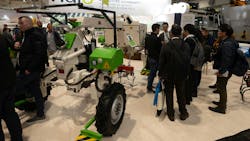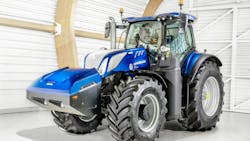Agritechnica 2025 to Highlight Trends Impacting Agricultural Equipment Design
Agritechnica 2025 kicks off on November 9 and will once again highlight the latest technological developments taking place within the agricultural equipment industry as well as the trends shaping machine and system designs.
The biannual event held in Hanover, Germany, has become one of the largest international events for the agricultural equipment industry. It is where machine OEMs and component suppliers — including those in the fluid power and broader power transmission industry — from around the world go to showcase their technologies aimed at making farmers more productive and efficient.
Quick Facts about Agritechnica 2025
Held every other year, Agritechnica continues to be one of the largest events for the agricultural equipment industry by attracting exhibitors and attendees from around the world. Here are some quick stats about the 2025 edition to help demonstrate its importance to the industry:
- 2,700 exhibitors from over 50 countries are confirmed
- 23 halls of fully booked exhibition space structured by defined product areas
- 430,000 visitors are expected
- 7 Theme Days tailor events and presentations to professional visitor groups
- 860 exhibitors in the Systems & Components segment (Halls 15, 16 and 17) featuring suppliers of hydraulics, drivetrains, electronics and other components.
These technologies demonstrate not only the innovation taking place within the sector but also how various trends are influencing the development of machines and components to meet the ever-evolving needs of the agriculture industry.
Trends Shaping Agricultural Machinery Designs
There are three key industry trends shaping agricultural machinery designs — and the mobile off-highway equipment industry as a whole — which will be on display at Agritechnica 2025. These trends are not new to the industry, indicating their continued relevancy and influence on technological developments.
Digitalization
Adoption of digital tools continues to grow in the agriculture industry, including those utilizing artificial intelligence (AI) and enabling connectivity between machines and farm management tools.
Many digital technologies are seen as a way to help increase the efficiency and productivity of farmers who are being tasked with producing more for a rising global population. The digitalization of machines, through the incorporation of sensors, software and controllers, is helping to increase their precision and overall performance which can help farmers get more done in a shorter period of time.
Meanwhile, apps help monitor weather conditions and plan fieldwork so farmers can ensure they are making the most of their time in the field. Various commercial solutions are enabling smart grain storage and automated documentation, further aiding productivity for farm owners.
According to a study conducted by DLG (German Agricultural Society), organizers of Agritechnica, 90% of German farms currently use at least one digital technology. However, adoption of digital tools remains uneven as smaller farms struggle with the costs associated with employing digital tools and poor internet infrastructure can be a challenge as well.
The DLG study also found that many farmers still struggle with knowing which tools to use and how they can be of help. As such, the association says training is necessary to help farmers better understand what tools are available and how to use them.
DLG is hoping to overcome this barrier at Agritechnica 2025 by highlighting those companies exhibiting digital solutions with whom attendees can meet to learn more. In addition, a new feature at the show will be the Digital Farm Center in Hall 21 of the exhibition grounds where digital solutions such as robotics and AI will be showcased and a dedicated speaking area will provide opportunities to learn about the capabilities of various digital technologies.
Automation
Tied to the digitalization trend is automation which also relies on sensors, software and other components to improve the control of machines and systems. Steering of tractors, combines and other agricultural equipment has been semi-automated for years, allowing farmers to focus their attention on higher priority tasks while the steering system navigates through the crop rows.
Advancements in recent years in drive-by-wire systems, cameras, sensors — many of which will be on display at Agritechnica 2025 — are enabling higher levels of autonomy, enabling a number of tasks to be completed without human involvement. And in some cases, humans are being completely removed from the machine cab. Like many industries, agriculture is facing a skilled labor shortage; with autonomy, farmers can continue to plant and harvest crops as usual even if they have less personnel.
DLG noted that semi-autonomous systems in combine harvesters such as automated threshing adjustments based on moisture levels, slope compensation for safe maneuvering through fields, and sensor-controlled fans and sieves to minimize grain loss are examples of some of the technologies now being utilized in the agriculture market, and which can be seen at Agritechnica 2025.
Robotics has slowly been entering the market as well, and will also be a technology of interest at the show. For instance, some companies have developed small robots capable of maneuvering through crop rows for weeding operations. They operate continuously 24 hours a day, 7 days a week if necessary, freeing farm personnel to work on other things or go home to their families at a reasonable time without sacrificing productivity.
DLG has stated that agricultural OEMs Claas, John Deere, Case and Fendt will be among those showcasing their latest autonomy technologies at this year’s Agritechnica.
Watch our video interview below with Noah Schwartz, Lead Perception Engineer at John Deere to learn more about the technologies used in its autonomous tractor first introduced at CES 2022.
Electrification and Alternative Fuels
Use of alternative drive technology is increasing in the agricultural equipment industry. While reducing emissions is prompting the transition to diesel alternatives, for many it is more about the operational benefits that can be achieved since this equipment is used for work and there needs to be a good business case for implementing an alternative energy technology.
These alternative drives can be found in the form of engines powered by alternative fuels such as methane and biodiesel as well as battery-electric powertrains.
At Agritechnica 2025, New Holland Agriculture plans to debut its T7.270 Methane Power CNG (compressed natural gas) tractor which will be commercially available in Europe starting in Spring 2026. The tractor is powered by a 270 hp engine and designed to offer performance on part with its diesel counterpart. It is capable of running on biomethane derived from livestock manure and fugitive methane captured onsite, allowing farmers to be the source of their own fuel and thus reduce operational costs.
DLG is seeing electrification make its way into the agriculture industry as well, though uptake remains limited to smaller machines in the 100-130 hp range. As with other off-road machinery applications, electrifying larger equipment is a challenge due to the large batteries required to meet horsepower demand. Charging can be difficult in farming applications as well.
But for those in which smaller electric-powered machines can be used, famers can benefit from the advantages of using an electric machine such as reduced maintenance due to fewer mechanical parts.
DLG noted in a pre-show press release that several companies will be showing their electric machines, including John Deere who intends to show its 130 hp battery-powered tractor at the show.
Chinese manufacturer ZSHX Advanced Tractors will also show its XEEVO E904i tractor which was designed from the ground up to be a battery-powered machine. Its drive concept features two electric motors arranged side by side. One is used for the drive, the other for driving the rear PTO and working hydraulic pumps. It is powered by a 105 kWh capacity battery installed in the front half-frame of the tractor for optimal weight distribution.
Through these trends we can see where the agricultural equipment industry is at today from a technological perspective as well as the influence will continue to have on shaping the design of machinery and the systems which power them, such as hydraulics, for years to come.
About the Author
Sara Jensen
Executive Editor, Power & Motion
Sara Jensen is executive editor of Power & Motion, directing expanded coverage into the modern fluid power space, as well as mechatronic and smart technologies. She has over 15 years of publishing experience. Prior to Power & Motion she spent 11 years with a trade publication for engineers of heavy-duty equipment, the last 3 of which were as the editor and brand lead. Over the course of her time in the B2B industry, Sara has gained an extensive knowledge of various heavy-duty equipment industries — including construction, agriculture, mining and on-road trucks —along with the systems and market trends which impact them such as fluid power and electronic motion control technologies.
You can follow Sara and Power & Motion via the following social media handles:
X (formerly Twitter): @TechnlgyEditor and @PowerMotionTech
LinkedIn: @SaraJensen and @Power&Motion
Facebook: @PowerMotionTech

Leaders relevant to this article:



